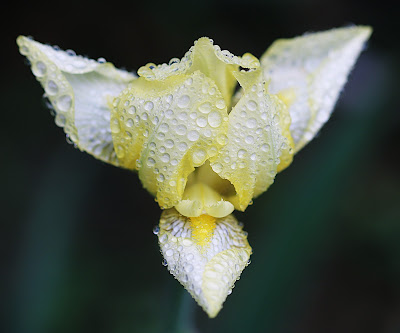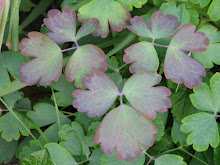Undaunted, I decided to start a new set of seeds once the weather got warm enough. Inside, of course, because we're working on new options for the front field, and it's not ready for planting yet. I felt fairly prepared. I had big, shallow plastic tubs...a soil-less mixture of peat moss and vermiculite...and clear labels.
I'd even gone through the trouble of cold-stratifying my perennial seeds - moving them from freezer to refrigerator to freezer - to help break their exterior shell.
In no time at all, I had tiny rows of seedlings.
Then I realized - GASP. We were heading into a week of rain, and I'd have no real light to aid my plants. Without some kind of light, they'd become spindly and die. Emergency run to Menard's for shop lights.
Since I'd planted so many tubs, we had grow lights, rows of tubs, and big tangles of extension cords everywhere. The lights dried out the soil, and then I realized the reason why people start their seeds in those thin plastic containers that sit in long plastic trays: my plastic tubs didn't have drainage holes, and that you aren't supposed to top-water. You pour your water into the plastic trays and the plants absorb as much as they need. But it was too late to remedy that, so it was constant spritzing with the water bottle to keep the soil moist.
I was so pleased with the progress and germination rate...and then I saw roots hitting the container bottoms. I realized with a Simpsons-level D'oh! that another reason why people use those black plastic containers is that they're about 5 - 6 inches tall, allowing room for root growth. With Todd shaking his head and wondering at my sanity ("We can just buy full-grown plants when the garden is ready!"), I set about re-potting over 1,000 seedlings into deeper containers.
The transplanted seedlings have to be watched carefully, because they're out in the sun now. Late-afternoon sun is too hot for them, so they all have to be dragged into the shade.
Of course, they cannot take the torrential rains that we've been having. Just the other day, we had hail!
Last night we had another flash storm, so, since there's no room inside for so many tubs, I dragged them all to a protected spot under the pine trees and covered them with a tarp. The next morning, I discovered that rain had pooled on top of the tarp, pressing the delicate stems flat into the soil.
ARGH!!!!
They seem to be incredibly resilient, though. I've got them back in the sun, and I suspect - hope - that they'll straighten up today.
Of course, I have another ten tubs to transplant. I am devoting an hour a day to it, trying not to feel discouraged, and hoping that I can salvage this mess and get everything into the garden by the 2nd week of June.
Other experiments have been a little discouraging. "I'm going to re-pot this volunteer sunflower from my front garden!"
Whomp whomp.
"Maybe I can ripen seed heads away from the parent plant, since it's been so wet that some of them are rotting, or I just miss them completely! I can't seem to find much information online, but it makes sense. I'll label them, dry them, and collect the seeds at my leisure."
(Two hours later, I'm informed on a garden forum that it just doesn't work this way, and that seeds should ripen on plant.)
I definitely feel like I'm stumbling blind through this, despite all the reading I've done. I have to console myself with the thought of next year's garden, when I will presumably make fewer mistakes. I'm trying to take some encouragement from the more established garden, too.
Irises are blooming!
They look so pretty.
One peony bloom so far, whose stem broke in last night's storm...but that just means a new bouquet. ;)
The catmint has filled in, so I finally get the purple-on-purple color scheme that I like so much.
The same with my lupines and false indigo.
New columbines are opening up! I bought any clearance columbine at Lowe's last year, even without knowing the color. They're so resilient, and they re-seed so well, that one single columbine will have enough seed to color an entire garden! My two newest colors: pure white and pale yellow. I love it!
Bleeding hearts are still going strong...and it's nearly June!
Yarrow, delphiniums, balloon flowers, foxgloves, daisies...all ready to open up soon. We've got beautiful sun in between all the storms...
(back pond and field)
And sometimes, in the house. :)
Have a great week!







































































